Buzz Haven: Your Source for Trending Insights
Stay updated with the latest buzz in news, trends, and lifestyle.
Django and Chill: Building Apps with Style
Unleash your creativity with Django! Join us for tips, tricks, and stylish app-building vibes that make coding a breeze. Dive in now!
Getting Started with Django: A Beginner's Guide to Framework Fundamentals
Getting started with Django can be an exciting journey into the world of web development. Django is a high-level Python web framework that encourages rapid development and clean, pragmatic design. As a beginner, you'll first want to familiarize yourself with its fundamental concepts. Begin by installing Django and creating your first project using the command django-admin startproject myproject. This command sets up the foundation for your web application with essential files and directories. Once your project is ready, understanding the architecture, which follows the Model-View-Template (MVT) pattern, will help you structure your application efficiently.
Next, it's crucial to learn about Django's built-in features that simplify various aspects of web development. Start with models to define your data structure, followed by views to manage the logic of your application. Finally, templates will allow you to render content dynamically. Here’s a basic roadmap to follow when learning Django:
- Understand the project structure and configuration.
- Create your first model and set up the database.
- Build views to handle user requests.
- Design templates for your web pages.
By following these steps, you'll gain a solid foundation in Django, enabling you to create robust web applications.

Top 5 Stylish UI Frameworks to Integrate with Your Django Apps
When developing web applications with Django, incorporating a stylish UI framework can significantly enhance the user experience and interface design. The top five stylish UI frameworks to integrate with your Django apps are:
- Bootstrap: A popular choice among developers, Bootstrap offers a responsive grid system and pre-designed components, making it easy to create visually appealing pages quickly.
- Tailwind CSS: A utility-first CSS framework that allows for rapid style customization. With Tailwind, you can build unique designs while maintaining a consistent look across your application.
- Bulma: This modern CSS framework is built with Flexbox, offering a clean and minimalistic design. Its simplicity and elegance make it perfect for integrating into Django applications.
- Foundation: Developed by ZURB, Foundation provides robust components and customization options, enabling developers to create responsive layouts that look great on any device.
- Materialize CSS: Based on Google’s Material Design principles, Materialize CSS gives your Django apps a sleek, modern aesthetic that enhances usability and performance.
Integrating these stylish UI frameworks with your Django applications not only improves aesthetics but also boosts user engagement. By focusing on design and usability, developers can craft applications that are both functional and visually appealing. Choosing the right UI framework is crucial, as it can dictate the overall user interaction experience. Whether you prioritize responsiveness, customization, or ease of use, each of these frameworks offers unique strengths that can cater to your specific project needs.
Common Django Mistakes: What Not to Do When Building Your First App
Building your first Django app can be an exciting yet challenging experience. One of the common Django mistakes that new developers make is neglecting the importance of proper project structure. Failing to organize your apps and files can lead to confusion and make your code harder to maintain. Ensure that you separate your concerns by creating dedicated apps for various functionalities, and utilize Django's built-in tools for structuring your project effectively. This will not only help you keep your code clean but also make collaboration with other developers much smoother.
Another frequent pitfall to avoid is inadequate use of Django's built-in features. Many beginners try to reinvent the wheel instead of leveraging the robust features that Django provides. For instance, using Django's ORM is essential to manage your database interactions efficiently. Additionally, newcomers often forget about security best practices, such as properly managing sensitive data and ensuring that forms are validated. By taking advantage of what Django offers and adhering to security protocols, you can build a more robust and secure application from the ground up.